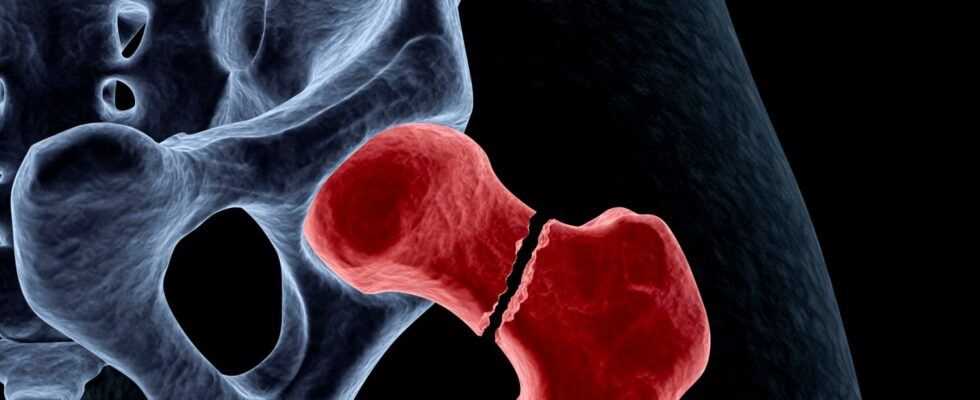The risk of a femoral neck fracture increases in older people; a simple fall is often enough. The hernia must be operated on as quickly as possible. For the very old, however, hospitalization poses a real danger.
- A femoral neck fracture usually requires surgery in older people.
- © iStock.com/Raycat
A femoral neck fracture happens quickly: once tripped over the edge of the carpet or lost your balance and fell, and the sensitive bone directly below the hip joint breaks. Doctors also speak of a femoral neck fracture or a fracture (fracture) of the femoral neck. Old people are particularly affected. In most cases, a femoral neck fracture requires surgery. The faster this operation takes place, the better the chances of recovery.
Article content at a glance:
What is a femoral neck fracture?
The thigh bone (femur) leads from the knee joint to the hip joint. It is the longest bone in the human body. At the hip joint, part of the bone bends into the hip joint – the femoral neck. If the bone is damaged by osteoporosis, it breaks easily at this point. Even a barely visible hairline crack can lead to severe pain and functional impairment. Often, however, the two bone parts are shifted or twisted with respect to one another. The femoral neck fracture often means that the femoral head is no longer adequately supplied with blood. Then the femoral head dies very quickly.
Causes of a femoral neck fracture
Every year around 100,000 people with femoral neck fractures are treated in Germany. Up to a quarter of all women will break these bones in their lifetime. In men, only five to eleven percent are affected.
Younger people, on the other hand, have less fear of a femoral neck fracture: In their case, the thigh bone only breaks after being subjected to strong violence, such as falling from a bicycle or an accident. In older people, on the other hand, osteoporosis has broken down the bone tissue and the bone loses its resistance as a result. A bone then breaks even with little force. Often a fall from a chair or on a staircase is enough to fracture the sensitive femoral neck. The older people get, the more common femoral neck fractures become. A tumor can also be the cause of a femoral neck fracture.
Severe pain in the femoral neck fracture
Usually severe hip pain is the first symptom of a femoral neck fracture. Those affected can no longer perform well. Other symptoms can also occur:
The leg is restricted in its movement and rotation.
The affected person cannot lift the leg in a straight position.
You can see swelling and / or bruising over the hip joint.
Sometimes the injured leg looks shorter than the other and is turned outward.
The pain radiates to the knee or hip.
In some cases, however, those affected feel little and the pain only occurs after a few days.
Diagnosis of femoral neck fracture
In the case of a fracture of the femur, quick help is crucial. A doctor should therefore be consulted as soon as possible. He will first ask about a fall and inquire about previous illnesses. The general condition of the person concerned is also important for the doctor.
Other typical questions are:
Have you ever had an operation on one of the hips?
Have you been restricted in your movement before?
Do you live alone?
What medications are you taking?
Then the doctor will perform a physical examination. He gently moves his leg to hear exactly when it hurts. He also sees whether there are bruises or even open wounds. If a femoral neck fracture is suspected, the doctor will X-ray the affected hip. Before that, the patient is usually given a pain reliever. At the same time, the blood values and the blood group are determined. CT, MRI or sonography are only necessary if the location is very ambiguous. It is important to distinguish a femoral neck fracture from a fracture of the hip socket or pelvis. To reduce the pain, the patient is usually placed on a vacuum mattress.
According to Pauwels, doctors distinguish three types of femoral neck fractures:
Type 1: The bone is compressed, the angle between the two break points is a maximum of 30 degrees.
Type 2: The bones are not compressed, the angle of fracture is 30 to 50 degrees.
Type 3: The bones are not compressed, the angle of fracture is more than 50 degrees.
Surgery is usually necessary in the case of a fractured femur
Conservative treatment without surgery is only possible for a thigh fracture if the two parts of the broken bone are not displaced from one another. Specialists call this an indented fracture. Then the leg is immobilized with a splint and can grow back together. Doctors also prefer conservative treatment for people with severe heart problems or in poor general health.
In most cases, however, the two parts of the bone are displaced or twisted towards each other. Then the fracture has to be operated on. There are two options for this: the bone-preserving procedure or the use of a prosthesis. The operation should take place within 24 hours of the fracture.
Preservation of your own bone during the operation
If the femoral head is sufficiently supplied with blood, the doctor tries to preserve it (osteosynthesis). Then he fixes the fracture again under general anesthesia so that the two parts of the bone lie correctly on top of each other again. The surgeon fixes this position with screws. Different types of screws are available for this. This method is particularly used in younger or very active patients. To do this, however, the break must not be more than 24 hours ago and the head and neck fragment must be sufficiently large. Then the leg has to be relieved for about six weeks – that is, the patient has to walk on crutches. With this procedure, the mean length of stay in hospital is 11.7 days.
Dual head prosthesis: Use of a joint replacement
In older patients, however, the femoral head is often only poorly or not at all supplied with blood. Then he can no longer grow together. Therefore, in this case, the femoral head including the femoral neck is replaced by a prosthesis (artificial joint). This is inserted into the existing bone shaft. The advantage of the artificial hip joint is that the patient can immediately put weight on his leg again. The dual head prosthesis is also recommended for patients with rheumatic diseases, advanced osteoporosis or a disability of the uninjured leg. Those affected remain in hospital for an average of 12.4 days.
The doctor decides which of the two procedures makes sense based on the patient's state of health and the type of break. In some cases he also suggests a total endoprosthesis (TEP): Then both an artificial joint head and an artificial joint socket are inserted. However, this requires major surgery.
Rehabilitation after a femoral neck fracture
Relatives and the hospital should clarify at an early stage how the rehabilitation will proceed after the hospital stay. If the person concerned is fit and active overall, outpatient rehab is recommended. For older patients, on the other hand, inpatient rehab has proven itself. Anyone who suffers from dementia should return to their familiar surroundings as soon as possible, such as their care home or family.
Important components of rehab are muscle building and coordination training, guided by physiotherapists. They also give advice on how to avoid falls in the future. The goal of treatment is to enable those affected to walk normally again. Patients should also take drugs that prevent thrombosis for up to four or five weeks after the operation. In the long term, doctors recommend sports such as swimming or cycling in order to maintain the muscles. On the other hand, sudden loads such as jumping should be avoided.
Healing time for a thigh fracture
After the operation, it is important that the patient is mobilized again as soon as possible. On the one hand, this prevents the risk of bedsores (bedsores) and thrombosis and, on the other hand, rebuilds the muscles. Physiotherapists show suitable exercises for this. Regular x-ray checks should ensure that the fracture has healed as desired or that the prosthesis fits well. In the case of an osteosynthesis, the doctor must ensure that the femoral head does not die later. If it does, a second operation is required. Problems with the prosthesis or the implant as well as infections can also make another operation necessary.
The older those affected are, the greater the risk that they will never be fully fit again after a femoral neck fracture. Movement restrictions often remain, especially in very old patients. A quarter of all those affected then become nursing care. On average, one in five does not survive the year following the accident. Lying down for long periods after an operation seems to be particularly harmful. That is why doctors rely on rapid mobilization of those affected.
Younger and physically fit patients, on the other hand, often recover completely after a few weeks. In most cases you can use your leg normally again. How long the healing process takes and how well it goes depends on both the type of fracture and the general physical condition of the person affected.
Preventing femoral neck fracture: Physical fitness protects
Comorbidities often lead to the falls, which in turn cause a femoral neck fracture. It is therefore important to treat underlying diseases well. Circulatory problems can lead to dizziness and an increased susceptibility to falls. Those who cannot see well recognize possible stumbling blocks too late. Smoking and excessive consumption of alcohol and sleeping pills are also considered risk factors.
However, it is helpful to keep yourself physically fit. With daily suitable exercises not only the muscles are built, but also the coordination is trained. This means that very old seniors can move safely inside and outside their home. A balanced diet high in protein supports this effect. In some cases, it is also useful to take vitamin D.
In addition, age-appropriate furnishings can prevent falls. Handrails can provide support, and good lighting can also provide security in winter and at night. Carpets and door sills should be removed where possible. Outside, sturdy shoes and walking aids help.



